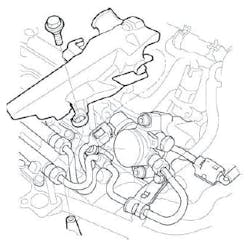Honda Pump Chirp
This bulletin applies to 2016-2018 Honda Pilot, 2017-2019 Ridgeline and 2018-2019 Odyssey vehicles. A high pitched chirping noise may be heard in the engine area with the engine warmed up. The probable cause is the high pressure fuel pump. According to Honda, this noise does not impact pump or engine function or reliability.
In order to eliminate the customer concern, replace the high pressure fuel pump.
Required parts are as follows:
PART ……………………… P/N ………………………… QTY
Fuel joint pipe set...............16012-R9P-315....................1
High pressure fuel pump....16790-RLV-305.....................1
Retainer.............................17711-S0X-931......................1
EGR pipe seal....................17103-RLV-A01.....................2
Intake manifold gasket......17101-RLV-A01......................6
Throttle body gasket...........17102-RLV-A01....................1
Intake manifold gasket........17065-R9P-A01...................1
Intake manifold gasket.........17055-R9P-A01..................1
EGR pipe gasket.....................18716-RB0-G01...............1
1. Relieve the fuel pressure.
2. Set No. 1 piston at top dead center (TDC).
3. Remove the intake manifold and intake manifold base.
4. Remove the high pressure fuel pump cover.
5. Remove the quick-connect fitting cover.
6. Disconnect the quick connect fitting.
7. Remove the fuel joint pipe.
8. Disconnect the high pressure fuel pump connector.
9. Remove the bolts by loosening them alternately, then remove the high pressure fuel pump and the roller.
10. Rotate the crankshaft and check the high pressure fuel pump cam for pits, scores and excessive wear. If needed, replace the rear camshaft.\11. Set No. 1 piston at TDC.
12. Install the roller onto the high pressure fuel pump cam.
13. Set the depth gauge on the roller and hold it, then set the dial to zero.
14. Rotate the crankshaft 720 degrees and measure the three cam lobes height. If the cam lobes are excessively worn, replace the rear camshaft. The high pressure fuel pump cam has three cam lobes. Cam lobe height (standard/new) is 0.236-inch (6.0 mm).
15. Set the No. 1 piston at TDC.
16. Check the position of the cam that drives the high pressure fuel pump.
17. Coat the roller, O-ring, cam and around the bore of the lifter with clean engine oil.
18. Install the roller and the high pressure fuel pump. Install the bolts loosely by hand in an alternate pattern. Connect the connector.
19. Lubricate the top of the new fuel joint pipe and the threaded area of the fuel rails and the high pressure fuel pump with polyethylene glycol included in the new fuel joint pipe kit. Do not re-use the old fuel joint pipe.
20. Tighten the fuel pipe nuts by hand until the end of the joint pipe is seated on the fuel rails and high pressure fuel pump.
21. Set the fuel joint pipe bracket on the cylinder head and loosely install the bolts.
22. Tighten the high pressure fuel pump mounting bolts to the specified torque of 18 ft.-lbs.
23. Tighten the fuel joint pipe bracket mounting bolts and the fuel joint pipe nuts to the specified torque in the proper sequence.
24. Connect the quick-connect fitting and install the quick-connect fitting cover.
25. Set power mode to ON but do not start the engine. After the fuel pump runs for about two seconds, the fuel line will be pressurized. Repeat this two or three times, and then check for fuel leakage.
26. Install the high pressure fuel pump cover and torque to 9 ft.-lbs.
27. Install the intake base and intake manifold.
